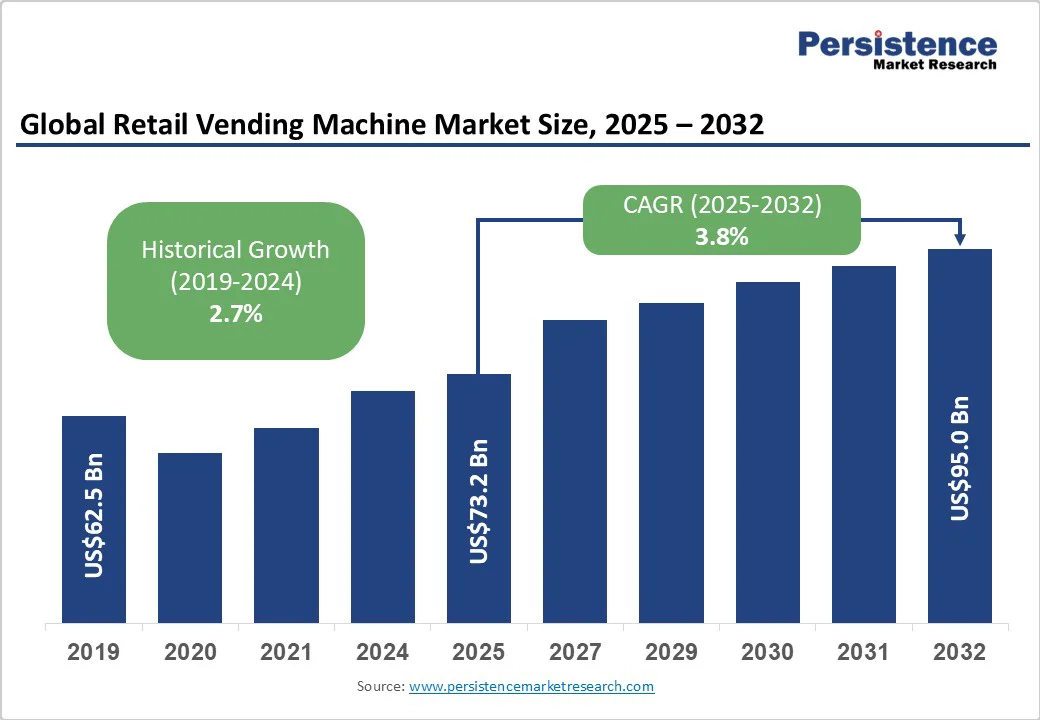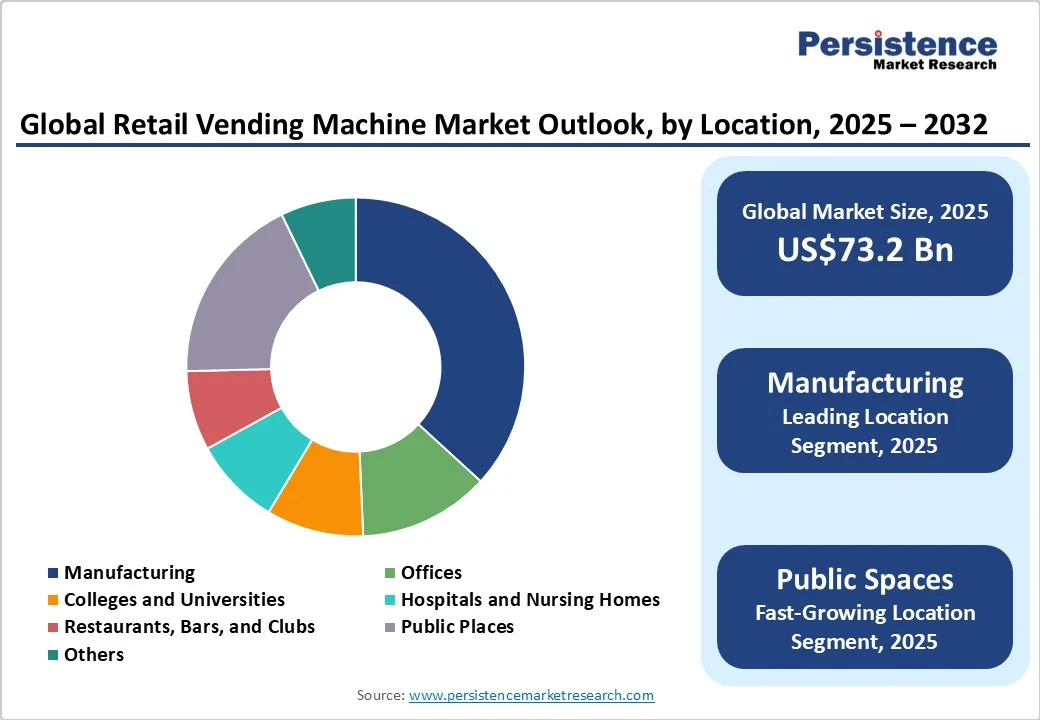ID: PMRREP35702| 195 Pages | 9 Oct 2025 | Format: PDF, Excel, PPT* | Consumer Goods

The global retail vending machine market size is likely to be valued at US$73.2 Billion in 2025. It is estimated to reach US$95.0 billion in 2032, growing at a CAGR of 3.8% during the forecast period 2025 - 2032, driven by rising demand for 24/7 access to snacks, beverages, and essential products globally. Smart vending machines and cashless payment options also encourage frequent use.
| Key Insights | Details |
|---|---|
| Retail Vending Machine Market Size (2025E) | US$73.2 Bn |
| Market Value Forecast (2032F) | US$95.0 Bn |
| Projected Growth (CAGR 2025 to 2032) | 3.8% |
| Historical Market Growth (CAGR 2019 to 2024) | 2.7% |

The high demand for 24/7 accessibility is a key driver in the retail vending machine market. Consumers now expect to access products such as snacks, beverages, and essentials at any time, reflecting a shift toward convenience and flexibility in their purchasing habits.
This trend is evident in various locations, such as airports, hospitals, and residential complexes, where vending machines operate around the clock to meet consumer needs. For instance, the introduction of 24/7 pizza vending machines in Ireland has been met with enthusiasm, providing fresh, artisan pizzas at any hour, catering to late-night cravings and busy schedules.
The modern consumer's preference for self-service options is boosting the popularity of retail vending machines, especially in high-traffic areas. These machines will provide a quick and efficient shopping experience, eliminating the need for human interaction, and appealing to those seeking speed and autonomy.
Locations such as train stations, airports, and shopping centers are prime spots for these machines as they cater to time-sensitive individuals. The trend is supported by technological developments, including cashless payment options and AI-based features, improving the functionality and appeal of vending machines in these bustling environments.
Retail vending machines are prone to various technical issues that can disrupt service and lead to product loss. Common problems include product jams, payment system malfunctions, and temperature control failures. For example, dirty or worn sensors can cause bill acceptors to reject valid currency, while misaligned dispensing mechanisms may prevent products from being delivered to customers.
Such malfunctions not only frustrate customers but also result in lost sales and diminished trust in the machine's reliability. Operators must implement regular maintenance schedules, monitor machine performance, and address issues promptly to minimize downtime and ensure consistent service.
Retail vending machines provide a fixed selection of products at predetermined prices, limiting consumer choice and the ability to negotiate. This lack of flexibility can deter customers who seek personalized options or discounts, especially in environments where bargaining is common. For instance, in retail settings, customers often expect to negotiate prices, a feature absent in vending machine transactions.
The limited space in these vending machines also restricts the variety of products that can be provided, potentially leading to missed sales opportunities if consumer preferences shift or demand fluctuates. Operators must carefully select products that cater to their target audience and consider alternative models, such as smart vending machines that offer dynamic pricing and a broad range of choices.
Smart vending machines are transforming traditional retail by integrating novel technologies such as artificial intelligence, real-time inventory tracking, and cashless payment systems. These machines deliver personalized experiences, including recommending products based on user preferences, and can dynamically adjust pricing.
For example, Farmer's Fridge utilizes IoT-enabled refrigerated kiosks to provide fresh meals, improving convenience and customer engagement. The global smart vending machine market is projected to rise significantly, with intelligent vending machines expanding at an impressive CAGR.
Energy-efficient vending machines are gaining traction due to their ability to reduce operational costs and environmental impact. These machines incorporate features such as LED lighting, high-efficiency compressors, and occupancy sensors to minimize energy consumption.
Studies indicate that such machines can cut electricity use by up to 35%, benefiting both the environment and business owners. Implementing energy management systems further improves efficiency by placing machines into low-power standby modes during periods of inactivity.
Beverage vending machines are predicted to account for nearly 45.3% of the market share in 2025, owing to their ability to provide quick and convenient access to drinks in high-traffic areas. For instance, in workplaces, employees often seek quick refreshments without leaving the premises, making on-site beverage machines highly desirable. Additionally, advancements in vending technology have enhanced the user experience by introducing features such as cashless payments and real-time inventory tracking.
Snacks vending machines are poised to exhibit a high CAGR through 2032, backed by their ability to meet the constant demand for quick and accessible food options. High-traffic locations, such as shopping malls and educational institutions, benefit from the convenience these machines offer to busy individuals seeking a quick snack. The evolution of consumer preferences toward healthy snack choices has further led to the rise of machines stocked with nutritious options such as granola bars and baked chips.
Manufacturing facilities are expected to hold a share of approximately 36.8% in 2025 due to the high number of employees working across multiple shifts. These workers often have limited time for breaks and may not have easy access to off-site food options.
By providing on-site vending machines, companies can deliver employees quick access to snacks and beverages, improving convenience and reducing downtime. These machines may also be stocked with healthy food options, catering to diverse dietary preferences and promoting employee well-being.
Public spaces are expected to record a high CAGR from 2025 to 2032, as vending machines can effectively cater to the diverse needs of a population. Locations such as parks, libraries, and transportation hubs experience consistent foot traffic, providing a steady stream of potential customers. For example, the installation of vending machines delivering free sanitary products in public spaces across Melbourne aims to address period poverty and ensure accessibility for all individuals.
With a share of about 76.1% in 2025, the cashless segment is predicted to dominate the market. Digital transactions, including mobile wallets and contactless cards, eliminate the requirement for exact change, thereby improving the purchasing process. This convenience encourages spontaneous purchases, often leading to high spending amounts. For instance, studies have shown that mobile payments can drastically increase the average amount spent per transaction.
The cash segment will likely register a high CAGR in the foreseeable future, as it remains a preferred option in areas with limited access to banking services or among populations that are unbanked or underbanked. Cash transactions offer anonymity and are exempt from digital transaction fees, making them an appealing option for cost-conscious individuals. Additionally, in regions where digital infrastructure is lacking or unreliable, cash provides a dependable method of payment.

The Asia Pacific is predicted to account for approximately 57.4% of the market share in 2025, driven by the rise of smart vending machines that integrate technologies such as artificial intelligence, the Internet of Things (IoT), and cashless payment systems.
These innovations improve user experience and operational efficiency. For instance, Fuji Electric and Coca-Cola have collaborated to develop hydrogen-powered vending machines that operate without a traditional power outlet, delivering superior installation flexibility.
Japan leads the region in terms of the adoption of intelligent vending machines, while China is expected to register the highest growth rate in the next ten years. The beverage segment remains the largest revenue-generating product category, with food vending machines experiencing the fastest growth.
North America is expected to expand at a high CAGR through 2032, as the region diversifies beyond traditional snacks and beverages. Unique concepts such as automated pizza dispensers are gaining traction. For example, PizzaForno's machines in Michigan deliver freshly baked 12-inch pizzas in about three minutes, catering to the rising demand for quick and automated food options.
Vending machines are further expanding into unconventional product categories. In Alabama, AI-based vending machines dispense ammunition, utilizing facial recognition and ID scanning for age verification. These machines operate 24/7, providing customers with convenient access to products typically sold through traditional retail channels.
From 2025 to 2032, Europe’s market is expected to grow, driven by diversification in product ranges and technological advancements. Smart vending machines are at the forefront of this evolution, integrating features such as cashless payments, real-time inventory tracking, and personalized user experiences. These developments cater to the rising demand for convenience and efficiency among consumers.
For instance, vending machines now deliver a wide range of products, from traditional snacks and beverages to electronics, beauty products, and even freshly prepared meals, reflecting a shift toward versatile retail solutions.
Geographically, Italy leads the regional market with the highest number of installed vending machines, approximately 835,000 units as of 2024. Germany follows closely, with around 520,000 machines, generating the highest revenue in the region at €2.8 billion (US$3.28 billion).
The global retail vending machine market is experiencing dynamic competition backed by evolving consumer preferences and technological developments. Key players such as Fuji Electric, Azkoyen Group, and Crane Merchandising Systems are leading innovations in smart vending solutions, while companies from other industries are also entering the market. For instance, Lavazza, an Italy-based coffee maker, is planning to acquire a full stake in machine vendor IVS, aiming to integrate its coffee products with vending services.
Companies are focusing on smart vending integration, delivering cashless payments, and diversifying product ranges to attract varied consumer segments. Strategic placement in high-traffic areas, collaboration with local brands, and sustainability initiatives, including energy-efficient machines, improve visibility, convenience, and brand loyalty, propelling consistent growth and competitive advantage.
The retail vending machine market is projected to reach US$73.2 Billion in 2025.
The rising demand for 24/7 convenience and self-service shopping experiences is a key market driver.
The retail vending machine market is poised to witness a CAGR of 3.8% from 2025 to 2032.
Expansion into high-traffic public spaces and integration with local brands are the key opportunities.
Azkoyen Group, Royal Vendors, Inc., and Westomatic Vending Services Limited are a few key market players.
| Report Attribute | Details |
|---|---|
| Historical Data/Actuals | 2019 - 2024 |
| Forecast Period | 2025 - 2032 |
| Market Analysis | Value: US$ Bn |
| Geographical Coverage |
|
| Segmental Coverage |
|
| Competitive Analysis |
|
| Report Highlights |
|
By Product Type
By Location
By Payment Mode
By Region
Delivery Timelines
For more information on this report and its delivery timelines please get in touch with our sales team.
About Author